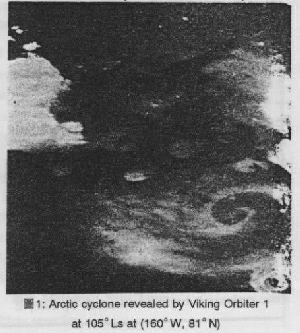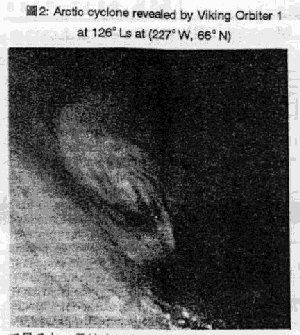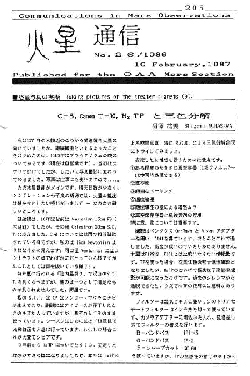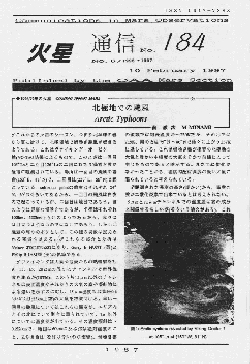COMING 1996/97 MARS -- ( 6 ) --
Arctic Typhoon - M MINAMI (English)
* From the spring to the summer season in the Martian northern hemisphere to which we are facing, some Typhoons seem to occur sometimes near the perimeter of the north polar cap, as were observed by the continued mission of Viking Orbiter 1 (VO-1). The present introduction to the arctic cyclones is based on the article by Garry E HUNT and Philip B JAMES, Nature 278 (1979) 531.
Fig.1: Arctic cyclone revealed by Viking Orbiter 1
at 105 degrees Ls at (160 degrees W, 81 degrees N)

* VO-1 observed twice the cyclonic cloud formation, once at 105 degrees Ls, and then at 126 degrees Ls. The first cyclone was observed at (160 degrees E, 81 degrees N), and the second was at (227 degrees E,66 degrees N). The latitudes of the sub-solar point at those seasons were about 24 degrees N and 20 degrees N respectively, and hence the first typhoon was inside the area where the midnight sun was seen, and the second must have been near the boundary. The radii of the cyclones were about 100km and 300km respectively. It must be impossible to see such tiny(?) cyclones from the terrestrially based stations, but they may cause a blur to the north polar region, and hence it will be reasonable to remember the phenomenon.
Fig.2: Arctic cyclone revealed by Viking Orbiter 1
at 126 degrees Ls at (227 degrees W, 66 degrees N)
 * The VO performed the IR thermal mapping (IRTM) at five channels at 7, 9, 11, 15 and 20 micron, and those except for 15 micron characterise the ground temperatures with small differences caused by the presence of dust and condensates in the atmosphere, while the 15 micron temperatures T15 are characteristic of the atmosphere at an altitude 25km at a pressure of 0.6 hectopascal. Fortunately the first Typhoon was under the IRTM measurements inside the storm area as well as at the adjacent area to the north. It showed that a large temperature gradient existed except for T15: The rate of the gradient was about 0.2K/km, and the change was seen up to about 60km wide. The ground temperature thus inside the cyclone was ~ 230K, but at the area to the north it read 215K, and at the opposite side at the area to the south between 75 degrees N and 80 degrees N, the temperature gradually rose up to 237K. The temperature difference must have been characteristic of the disturbances produced by the front which separated the frigid arctic air from the warmer mid-latitude atmosphere. The fact that there was no gradient in T15 implied that the cloud disturbance was confined to the lower atmosphere.
* The VO performed the IR thermal mapping (IRTM) at five channels at 7, 9, 11, 15 and 20 micron, and those except for 15 micron characterise the ground temperatures with small differences caused by the presence of dust and condensates in the atmosphere, while the 15 micron temperatures T15 are characteristic of the atmosphere at an altitude 25km at a pressure of 0.6 hectopascal. Fortunately the first Typhoon was under the IRTM measurements inside the storm area as well as at the adjacent area to the north. It showed that a large temperature gradient existed except for T15: The rate of the gradient was about 0.2K/km, and the change was seen up to about 60km wide. The ground temperature thus inside the cyclone was ~ 230K, but at the area to the north it read 215K, and at the opposite side at the area to the south between 75 degrees N and 80 degrees N, the temperature gradually rose up to 237K. The temperature difference must have been characteristic of the disturbances produced by the front which separated the frigid arctic air from the warmer mid-latitude atmosphere. The fact that there was no gradient in T15 implied that the cloud disturbance was confined to the lower atmosphere.
* The observed temperatures were too high for the cloud to be composed of the dry ice. It is said the difference of temperatures in the 9 micron and 11 micron channels suggests the composition of the cloud, and the result showed that the spiral clouds were made of the water ice. Otherwise, the violet image more vividly showed the difference from the ground than through the red light. It was also known that at that season the water vapour content of the atmosphere is maximal over the north polar region (C B FARMER et al). It is however very plausible that the cyclonic cloud formation must also be enhanced by the presence of dust: the stirred dust will easily help the condensation of ice particles by the nucleation mechanism.
* HUNT and JAMES also discuss the meteorological structure of the cyclones theoretically, and evaluated the wind velocities and accelerations as well as vorticities, but here the discussion is omitted (just the wind velocity turned out to be 31.5m/s for the first storm). The results seem to be compatible with those suggested by Viking Lander 2.
* The second cloud showed its shadow (taken at 6:33 local time), and it gave an estimation of a height of 6-7km. If a linear lapse rate is applied to the first cloud, this seems to be located at the altitude of about 4km.
Coming 1996/97 Mars (6)
北極地での颱風
-- 南 政 次
(Japanese)
♂....これからの火星のシーズン、つまり北半球の春から夏に掛けて、北極領域で渦巻き颱風が起きるようである。これはヴァイキング・オービター一號(VO-1)の結果によるもので、このときは一回目105゚Lsと二回目126゚Lsの二回にわたり渦巻き雲が極地に觀測されている。場所は一回目の颱風の場合(160゚E、81゚N)で、二回目は(227゚E、66゚N)で起こっている。sub-solar pointの緯度はそれぞれ 24゚N、20゚Nぐらいであるから、一回目の颱風は白夜内で起こっているが、二回目は境目であろう。圖のように見事な渦巻きであるが、半徑はそれぞれ100km、300kmぐらいのようであるから、我々には目立つようなものではないであろう。しかし北極冠の周りのボケとして、この種の現象は捉えられる可能性はある。
♂....これらの紹介と分析はNature 278(1979)531にあり、Garry E HUNT (英)とPhilip B JAMES (美)の執筆である。
Fig.1: Arctic cyclone revealed by Viking Orbiter 1
at 105 degrees Ls at (160 degrees W, 81 degrees N)

♂....ヴァイキングは大氣や地表からの熱輻射を7、9、11、15、20μmの五つのチャンネルで赤外温度を測るが(IRTM)、このうち15μm以外のチャンネルは表面温度やそれからの大氣の塵や凝結物による違いを示すのに対し、15μm温度T15は氣圧0.6ヘクトパスカル(25km上空)の大氣を特徴付ける。幸い一回目の颱風についてはこれらの温度が、エリア内とその北について別々に測られていて、T15 以外については温度差が出ている。その温度傾斜は〜0.2K/kmで、範囲は60kmに及ぶ(Kは絶対温度のこと、Kの場合ぱを付けないのが慣習)。渦巻き雲の領域では地表温度が〜230Kだが、その北では215K、南の方は75゚N〜80゚Nで徐々に上がり237Kに達している。これは渦巻き雲が極寒の北極地の大氣と暖かい中緯度の大氣を分かつ前線によって生じたものであると暗示する。またT15に變化がなかったことから、温度勾配は高度の低い大氣に限られていると考えられている。
Fig.2: Arctic cyclone revealed by Viking Orbiter 1
at 126 degrees Ls at (227 degrees W, 66 degrees N)
 ♂....觀測された温度の高さ(暖かい)から、渦巻き雲が二酸化炭素で出來ているとは考えられない。 9μmと11μmチャンネルでの温度差は雲の成分と関係するらしいが(そういう論文がある)、これで見ると、雲は水の氷で出來ているようである。他に、フィルターで透かして、赤色光よりも青色光で地面との差がより鮮明である、つまり青色光で好く出ているということがある、等である。もう一つ、これは何処かでも触れたが、この時季、北極冠邊りで水蒸氣量が最大になるという結果が、この頃發表されているのである。
♂....觀測された温度の高さ(暖かい)から、渦巻き雲が二酸化炭素で出來ているとは考えられない。 9μmと11μmチャンネルでの温度差は雲の成分と関係するらしいが(そういう論文がある)、これで見ると、雲は水の氷で出來ているようである。他に、フィルターで透かして、赤色光よりも青色光で地面との差がより鮮明である、つまり青色光で好く出ているということがある、等である。もう一つ、これは何処かでも触れたが、この時季、北極冠邊りで水蒸氣量が最大になるという結果が、この頃發表されているのである。
♂....但し、雲に塵が混じっていることは可能性がある。特に、冷却による水蒸氣の凝結の際に塵が核になっていることは間違いないとされる。
♂....このHUNT-JAMESの論考では、雲の内部の氣象的構造についても論じられ、風速なども評価されているがここではその論述は略す(30m/sぐらいである)。結果はヴァイキン・ランダー二號(VL-2)での結果と合っているようである。♂....二回目の雲には影が映っている様である(午前6時半)。これから高さは6〜7kmと出るようである(普通の雲で最高高さ50kmぐらいは知られている)。 これを諸条件から一回目の雲に当て嵌めると高さ4kmと出る由である。
10 Years Ago (14)
--- CMO #026(10 Feb 1987) (Japanese)

1987年になって火星は日没時には南中を過ぎて西に傾いているようになった。「うお座」を北上中で、赤緯は1月初めには北になって夜半の西空に残り、没は23時地方時頃だった。観測時間は夕方から数時間だけになったが、日本での南氏、台北での張麗霞氏のルーチン観測は続いていた。1月後半には視直径は6秒台に小さくなり、 Lsは320゚台になった。
OAA Mars Sectionに寄せられた、この期間と追加の報告は、南政次氏、張麗霞氏、中島孝氏、松本直弥氏の諸氏からだけになった。岩崎徹氏は1月の上旬で今期の観測を終了している。岩崎氏のスケッチ数は262枚に達した。
この期間にはM TyrrhenumからSyrtis Mj付近が見える時期だったが、最早詳細を捉えることは難しくなってしまっていた。南極や北縁の明るさも観測されているが、詳細を議論する段階でなく、次期の観測の目標として、記憶されたいと記されている。
記事としては、沼澤茂美氏による「惑星写真の実際(9) C-8, Canon T-90, H2-TP と三色分解」が掲載された。記事によると、沼澤氏は1983年頃より水素ガス増感処理コダックテクニカルバンフィルムによる天体写真を試されていたとの事で、1986年にはフィルターで B,G,Rの三色に分解撮影したテクニカルパンフィルムから、カラーリバーサルフィルムに合成する火星カラー写真に挑戦された。撮影に使用したフィルター、リバーサルカラーフイルムなど撮影資材とテクニックを惜しげもなく披瀝された。作例は「天文年鑑」1987年版のトップページに見ることが出来る。浅田正氏は「惑星写真の撮影についてのアンケート」回答の集計結果の第2回を纏めて発表された。「便り」には、浅田正氏宛のドン・パーカー氏からの来信が載っている。いよいよ御大の登場である。
(Mk) 村上昌己

 CMO #184
CMO #184  * The VO performed the IR thermal mapping (IRTM) at five channels at 7, 9, 11, 15 and 20 micron, and those except for 15 micron characterise the ground temperatures with small differences caused by the presence of dust and condensates in the atmosphere, while the 15 micron temperatures T15 are characteristic of the atmosphere at an altitude 25km at a pressure of 0.6 hectopascal. Fortunately the first Typhoon was under the IRTM measurements inside the storm area as well as at the adjacent area to the north. It showed that a large temperature gradient existed except for T15: The rate of the gradient was about 0.2K/km, and the change was seen up to about 60km wide. The ground temperature thus inside the cyclone was ~ 230K, but at the area to the north it read 215K, and at the opposite side at the area to the south between 75 degrees N and 80 degrees N, the temperature gradually rose up to 237K. The temperature difference must have been characteristic of the disturbances produced by the front which separated the frigid arctic air from the warmer mid-latitude atmosphere. The fact that there was no gradient in T15 implied that the cloud disturbance was confined to the lower atmosphere.
* The VO performed the IR thermal mapping (IRTM) at five channels at 7, 9, 11, 15 and 20 micron, and those except for 15 micron characterise the ground temperatures with small differences caused by the presence of dust and condensates in the atmosphere, while the 15 micron temperatures T15 are characteristic of the atmosphere at an altitude 25km at a pressure of 0.6 hectopascal. Fortunately the first Typhoon was under the IRTM measurements inside the storm area as well as at the adjacent area to the north. It showed that a large temperature gradient existed except for T15: The rate of the gradient was about 0.2K/km, and the change was seen up to about 60km wide. The ground temperature thus inside the cyclone was ~ 230K, but at the area to the north it read 215K, and at the opposite side at the area to the south between 75 degrees N and 80 degrees N, the temperature gradually rose up to 237K. The temperature difference must have been characteristic of the disturbances produced by the front which separated the frigid arctic air from the warmer mid-latitude atmosphere. The fact that there was no gradient in T15 implied that the cloud disturbance was confined to the lower atmosphere.